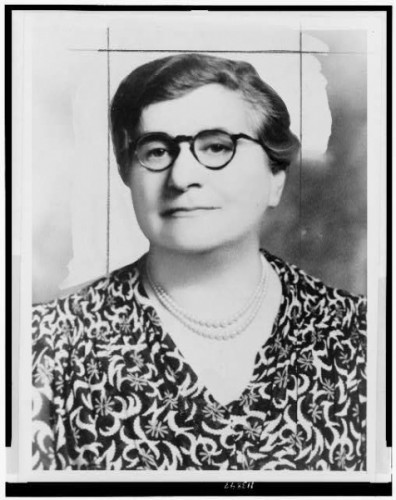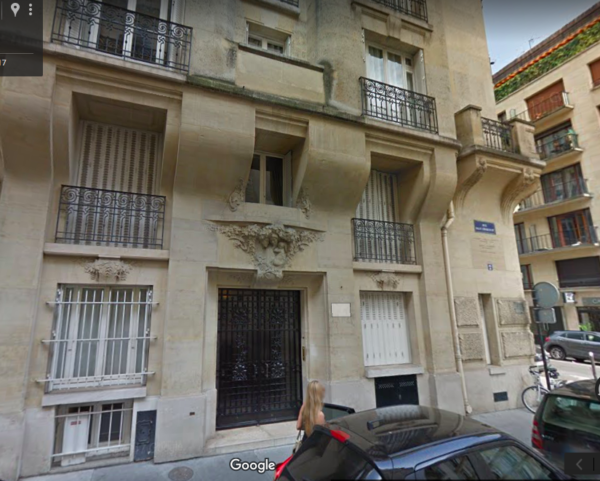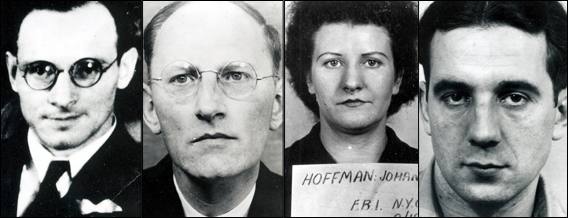They say that revolutions are for the young. That’s probably a truism when you look at the French Revolution and even to contemporary ones like Egypt’s “Arab Spring.” It may also apply to resistance movements during periods of conflict. When one studies the French Resistance during the German Occupation, it becomes clear very quickly that most resistance members are young (thirty-five or younger).

That is until you meet Etta Shiber, a 62-year old widow and former Manhattan housewife, who lived in Paris with her best friend before and during the Occupation—with the exception of the time she spent in a Gestapo prison.
Did You Know?
After nearly 600 years in England, a medieval ring belonging to Joan of Arc was returned to France. On the eve of her execution in May 1413, she gave the ring to an English cardinal. Throughout the centuries it was bought and sold multiple times. On 4 March 2016, it came back to France after an organization successfully bid $425,000 at auction. Reportedly, there is sufficient documentation to authenticate the ring as belonging to Joan.
Kitty
Etta and her husband traveled to Paris every year for a three-month stay. While there in 1925, she met Kitty who was to become her best friend. Kitty Beaurepos, the daughter of a London banker, was an English society woman who married young. Moving to Italy, she and her husband had a son but shortly after, her first husband passed away and Kitty moved to Paris. She married a Frenchman but then amicably separated. Kitty eventually opened a small dress shop on Rue Rodier where she catered to Americans and this is where the two women met.
Every year on her annual trip to Paris, Etta would call on Kitty. In 1933, Etta traveled to Paris without her husband but did take her ill brother. Irving became so ill that Kitty had to bring in the best medical help that Paris had to offer. Alas, it wasn’t enough and Irving died (he was buried in the Père Lachaise cemetery). William Shiber died three years later leaving Etta a widow. Kitty invited her to move to Paris and live with her at 2, rue Balny d’Avricourt in one of Paris’s more exclusive neighborhoods (near the Arc de Triomphe).

The Germans
For three years, Kitty and Etta’s lifestyle was calm, happy, and without any acrimony. That is, until 1 September 1939 when the Nazis began dropping their bombs on Poland and invaded the country. England and France almost immediately declared war against Germany. Kitty tried to talk Etta into returning to America but she refused. The next day, the two women joined the Foyer du Soldat—the French equivalent of our U.S.O.
For eight months after the invasion of Poland nothing happened. France would sit back as if nothing was amiss—they were in the middle of the drôle de guerre or “phony war.” The French government was confident that any German attack would be repelled by their army and by the Maginot Line. That is until mid-spring 1940 when the German Wehrmacht (army) and Luftwaffe (air force) began to quickly sweep into the neighboring Low-Countries, including France. It took only six weeks for the Nazis to conquer France (almost two million French soldiers were taken prisoner).
Flight From Paris
As the Germans approached the city, almost everyone in Paris fled south or west. They went by car, bike, or foot pulling their belongings behind them. The narrow roads became so congested that going only a few feet would take hours. Within days, the Luftwaffe sent in fighters to strafe the refugees fleeing their city.
Kitty and Etta followed everyone else. They hopped into Kitty’s car and began their slow journey south. Giving up on the main road after several days, Kitty turned the car onto an alternate route. However, by the next day the women decided it best to get back to the south-bound road. They reached it just in time to be attacked from the sky by Luftwaffe planes. Strafing the road, the German pilots killed scores of men, women, and children.
Rather than move on, most of the people (including Kitty and Etta) stayed where they were. Reports of the German troop movements made it clear they were trapped. Eventually, the German parade of soldiers caught up to them. A soldier on motorcycle drove up to the car and told them to return to Paris. So, Kitty and Etta turned around and began to drive back to Paris. Along the way they passed captured French soldiers standing alongside the roads guarded by the Germans. In some cases, these prisoners included English or R.A.F pilots—undoubtedly the ones who couldn’t get off Dunkirk beach.
William Gray
Paris had capitulated without a fight. The French government deserted the city for Bordeaux and declared Paris to be an “open” city. The Germans marched in without a shot being fired during the early morning of 14 June 1940. By the evening, the occupation forces had settled in. Kitty and Etta knew all about the recent events when they decided to stop at an inn to eat on their way back to Paris.
The innkeeper was very nervous. He told them he was hiding an English pilot and they all knew the Germans were hunting down these pilots. His name was William Gray and he had been stranded at Dunkirk. Kitty and Etta decided to take him back to Paris with them since he fit perfectly in the trunk of the car. They took the risk because Etta thought he looked like her deceased brother.
Along the way, they were stopped several times but the German sentries never bothered to open the trunk. They stashed Gray in their apartment. A week after they returned, a Gestapo agent and two French civilians knocked at their door. They were conducting a house-by-house search for downed English pilots. Etta passed Gray off as her sick brother using Irving’s identification papers. Their visitors left but noted that “Irving” now lived in the apartment.
Paris was still relatively empty but their friend, Chancel, was at his apartment when they contacted him for help in smuggling Gray out of the city and into the hands of the Resistance. They were quickly to find out that Chancel ran a refuge for people in hiding. They devised a plan to smuggle Gray to the border and freedom. The plan worked.
Missing Persons Ad
The women decided to go into the human smuggling business full time. They took out ads in the “Missing Persons” section of the German run newspaper Paris-Soir which read “William Gray, formerly of Dunkirk, is seeking his friends and relatives.” The ad attracted attention of Father Christian Ravier who, over time, supplied Etta and Kitty with soldiers hiding in the woods. By the fall of 1940, the women had successfully transported more than 150 men to safety and freedom.
Betrayed
Five months after bringing William Gray to their apartment, Kitty and Etta were betrayed. On the morning of 26 November 1940, a Gestapo agent knocked on their door. Only Etta was home and she was immediately arrested (Kitty would often leave for extended periods of time to make transfer arrangements with the Resistance). Brought to the Hôtel Matignon (one of the sites you’ll visit in my new book Where Did They Put the Gestapo Headquarters?), Etta met Captain Pietsch and Dr. Hager, two Gestapo officers who played the “good guy, bad guy” interrogation game with her. Two hours after Etta’s arrest, Father Christian, and Chancel were picked up by the Gestapo. Kitty managed to elude the hunters but only for the time being.
Prison and Certain Death
Etta was taken to the military prison, Cherche-Midi, where political prisoners were interred (the 120-year old prison located on Rue du Cherche-Midi was demolished in 1966). She was no longer Mrs. Etta Shiber but Prisoner Number 1876. After about two weeks, Etta was released but constantly followed by the Gestapo hoping she would lead them to Kitty. By mid-December 1940, the Gestapo found Kitty (without Etta’s help) and they arrested Mrs. Shiber once more. The Nazis now had the four “ring leaders” in custody.
All four were brought before the Nazi court in March 1941 at the Hôtel de Brienne (14, rue Saint-Dominique). Etta was charged with “aiding the escape into the free zone of military fugitives.” The United States had yet to enter the war against the Germans so Etta got off with a sentence of three years at hard labor. Chancel received five years. The other two were not as lucky. Kitty and Father Christian each received the death penalty.
Etta was transferred to the notorious Fresnes prison where she was expected to serve her sentence. As the weather turned colder, the Germans transferred her to a prison located in Troyes, France. The date was 7 December 1941. Etta was now an enemy of the Nazis.
The Exchange
The fourteen months in captivity since the trial were hard on Etta. She suffered from an irregular heartbeat, high blood pressure, and she had her first heart attack in February 1942. Her second attack came two months later. She dropped almost forty pounds but her smoking habit had been broken. Etta was released a second time and returned to Paris. In May 1942, she learned the reason why the Gestapo had let her out.
Etta was required to check in daily at the Kommandantur du Gross-Paris in the Place de l’Opéra (again, one of the stops in the next book). On 17 May at her daily visit, a German officer informed her that she was to leave that day to return to America. After waiting in the train at Hendaye (France) on the border with Spain for what seemed an eternity (it was actually a couple of days), Etta saw another train pull into the station after crossing the international bridge. A German military band had arrived to greet it along with the black Mercedes cars carrying Nazi dignitaries. Shortly after, a woman walked off the train and headed directly to the lead Mercedes.

Mrs. Etta Shriber had been exchanged by the United States government for one of the Nazis’ most notorious spies, Johanna Hoffmann. The famous spy was part of a Nazi espionage ring operating in America. She was caught and convicted of spying and given a four-year sentence in 1939.
Post-War
Etta returned to New York where she lived out her remaining years. She wrote about her experiences in Paris-Underground. Since the book was published in the middle of the war (1943), certain names were changed to protect her friends. Kitty was really Catherine (Kate) Bonnefous (nee Robins). Father Christian was an alias and his real name was never divulged. William Gray’s real name was used in the book because he was safely back in England and the Nazis couldn’t touch him.
Etta died three years after the war ended (no doubt from prison ailments) without ever knowing if her friend Kitty had survived—which she did but with permanent scars on her body to show for her time with the Gestapo. Father Christian was one hour away from being executed when two Gestapo agents showed up to transfer him. Believe it or not, they weren’t with the Gestapo. They were British MI6 agents dressed like and flashing Gestapo identity cards. They had come to rescue Father Christian. He was offered transportation to England but refused. He wanted to return to his village and continue his resistance work. No one ever heard from him again.
When Etta returned to America, she was hailed as a hero. All she said was “I was looking forward to a quiet old age.”


Recommended Reading and Viewing
Shiber, Etta. Paris−Underground. New York: Press Alliance, Inc., 1943.
Bennett, Constance (producer). Paris-Underground. Starring Constance Bennett and Gracie Fields. United Artists. Based on the novel by Etta Shiber. 1945.
Notice the date Etta’s book was published? Yep, she wrote it shortly after returning to America and right in the middle of the war. Many of the names have been changed to protect the identities of people who remained in German occupied territories. The book is dedicated to “Kitty.”
What’s New With Sandy and Stew?
Most of the soldiers that Etta and Kitty saved were English. These men tried to get out of France during the Dunkirk evacuation but were never able to get on any of the ships. There were thousands of them looking for a way to return to England.
We have a special blog next week from our friend Denis Caron. The blog is about the last soldier to return home from Dunkirk. You’ll learn about Bill Lacey and his adventures eluding the Germans after being stranded on Dunkirk beach. Denis is the author of Dash for Dunkirk.
Someone Is Commenting On Our Blogs
If there is a topic you’d like to see a blog written about, please don’t hesitate to contact me. I love hearing from you so keep those comments coming.
It’s Here Now!
Why Would You Want To Buy Our “Walks Through History” Books?
Simple.
You like to travel and experience history and historical events. You like to see original buildings that had a significant impact on the people and events of the history you’re engaged with. You want to know the stories behind the brick and mortar in front of you.
The walking tour books are meticulously researched so you can go directly to those sites and learn about the building’s history as well as an introduction to some of the more interesting people associated with it.
Thank You
Sandy and I appreciate you visiting with us. We have some exciting things on the horizon and we’ll keep you updated as we go along.
Share This:
Follow Stew:
Find Stew’s books on Amazon and iBooks.
Please note that we do not and will not take compensation from individuals or companies mentioned or promoted in the blogs.
Walks Through History
Copyright © 2018 Stew Ross



Stew,
Etta Shiber, author of Paris Underground is what I was searching for when I found your website. My grandmother gave me her book 50+ years ago and I periodically reread it, just to absorb the incredible bravery of Etta and Kitty, and to challenge my own sense of what it means to be brave. Additional info about her story has been scarce until I found your blog. For instance, I didn’t know Kitty’s real name or that she had survived the Nazis and that was a nice surprise. (Wish I could find a photo) I also enjoyed seeing their apartment and it was nice to be able to fill in a little more detail about Etta after the war.
I read many books about the women of the resistance, it’s kind of a hobby, so your website will be a great addition. I wonder if you have ever read the story of Nancy Wake, an Australian who fought with the resistance in France and commandeered a group of 7,000 resistance fighters, the Maquis, who lived in the woods. This woman is incredible so if you haven’t heard of her, you must read her story. There are two books about her and a documentary where she is interviewed. Fascinating.
Also, I am wondering if you have every heard the tale of Daniel Payseur. He is alleged to be Marie Antoinette’s son, Crown Prince Louis. who, if the story is true, was smuggled out of France, ended up coming to America, and who’s family acquired vast holdings around the world. This may be folklore without merit, but the Payseurs do indeed exist. I haven’t been able to find much information except for here:
https://www.truthcontrol.com/house-payseur but the reason it intrigues me is that our family history has it that an male ancestor of ours was related to the French Court at the time of the French revolution and was smuggled out of France, changed his name and came to this country. In researching this I came upon the Payseur story. Truth or fiction, who knows?
Anyway, thank you for such a fascinating website and look forward to reading all your posts with great enjoyment.
Regards,
Kimberly Mabry
So what happened to “kitty” and her son????
Thanks Steven for reaching out to us. Kitty survived the war after having been sentenced to death by the Nazis in March 1941. Her sentence was commuted to life in prison and over the next two or three years, Kitty was transferred from one prison to another. Her last stop was the Jauer concentration camp. Kitty was tried and convicted under the “Nacht und Nebel” decree (NN). Jauer was part of the Gross-Rosen camp system. Many of the inmates were used for forced labor in many German manufacturing facilities. It is likely this was her fate while in camp. According to the “Fondation Pour La Memoire de la Deportation,” Kitty was liberated from the camp in February 1945 by the Soviets. Kitty would have been fifty-nine years old. It is likely she was raped by the Soviet troops before being set free. The date of her death is unknown but it is probable that she would have had severe health issues from her four-years in the camps and prisons and might have died shortly after her release (speculation on my part). Unfortunately, I have no information about her son (I didn’t know she had one). Hope this answers most of your questions. Thanks for being a subscriber to our blogs! STEW
Bonjour ,
je suis le petit fils de Kate Robin .
Je peux répondre à quelques questions que vous vous posez.
Ma Grand-Mère a effectivement eu un fils , prénommé Len ( Léonardo ) né à ROME en juillet 1911 , il s’est marié avec Mireille FABRE (ma mère) en 1936 et à eu 2 fils : Yann (8/9/42) et Thierry (16/5/46).
Puis après leur divorce, il a épousé Christiane HARDY en 1953 et a eu 2 enfants : Erik (12/05/1956) et Olivia (10/61).
Ma grand-mère est décédée en 1965 ou 1966 à LONDRES.
Je suis à votre disposition si vous désirez d’autres informations.
Bien à vous,
Thierry Salès
Bonjour Thierry;
Merci de me contacter au sujet de votre grand-mère. J’apprécie le fond car il y a très peu d’écrit sur “Kitty” et son issue après la guerre. Il y avait des spéculations selon lesquelles elle n’a pas survécu, mais vos antécédents familiaux confirment sa survie. C’était une femme très courageuse. C’est très gentil de votre part de proposer de fournir des informations supplémentaires. STEW
Thierry is the grandson of “Kitty” whom we featured in our blog “I Was Looking Forward to an Old Age.”
I would love to know more about what happened to Kitty from Thierry!! Is it possible for you to interview him for any details?! Yours is the only site, it seems, which has info on her!!
Thank you!
Hi Kristen; Thanks for contacting me. Unfortunately, Thierry won’t be much help as his grandmother refused to tell anyone about her experiences. She died taking all the stories with her. The author doing a book on Etta and Kitty interviewed Thierry and walked away empty handed. I suspect this is the reason why there is no information available on the fate of Kate/Kitty or her son. I was fortunate that Thierry reached out to me with the news his grandmother survived as did her son. After the war, she settled into an apartment on Avenue de Wagram in Paris. Sorry I couldn’t be of more help. STEW
Found your site after watching “Madam Pimpernel.” You offer much more information that I located anywhere else during my search.
As Steven asked about Kitty and son, above under “Kitty” you have a sentence: “Moving to Italy, she and her husband had a son but shortly after, her first husband passed away and Kitty moved to Paris.”
I take this to mean Kitty had a son!?! Am I wrong?
Hi LA;
Thanks for contacting us in regards to your question concerning Kitty’s son. I don’t have any information on him other than he was born in Italy. I found that information on Kitty was pretty scarce. Sorry I couldn’t be of more help. Thank you for subscribing to our blogs. Hope you enjoy future as well as past blogs. STEW
I just saw “Madame Pimpernel” on YouTube and just got Etta Shiber’s book “Paris Underground” from the library and read it. Wow! I’m just glad and relieved to know that “Kitty,” in fact, did survive the war and went on to have grandchildren. I can understand her not wanting to talk about her experiences or tell her story – it was probably incredibly traumatic. We can only thank Etta for getting it all written down and published so incredibly soon after her experiences.
Hi Tim, thank you for your comments. I’m glad you were able to read Etta’s book. Yes, I would agree that Kitty’s experiences must have been so unpleasant that she refused to discuss them with anyone including her immediate family. STEW
I did a little research and came up with a fascinating website with further information about Kitty/Kate and Etta’s exploits as described by some of the soldiers they saved, and the possible identify of Father Christian. “Father Christian” (assume abbé Edouard Régnier)
http://www.conscript-heroes.com/Art54-Kate-Bonnefous.html
Hi Kimberly; Thanks for reaching out to us concerning the blog on Etta and Kitty. I appreciate you sharing the link to the site describing some of Etta and Kitty’s wartime activities. Very interesting. I have shared the link with Kitty’s grandson. Other than Etta’s book, there isn’t much out there, especially on Kitty. Hope you enjoy the future blogs. STEW